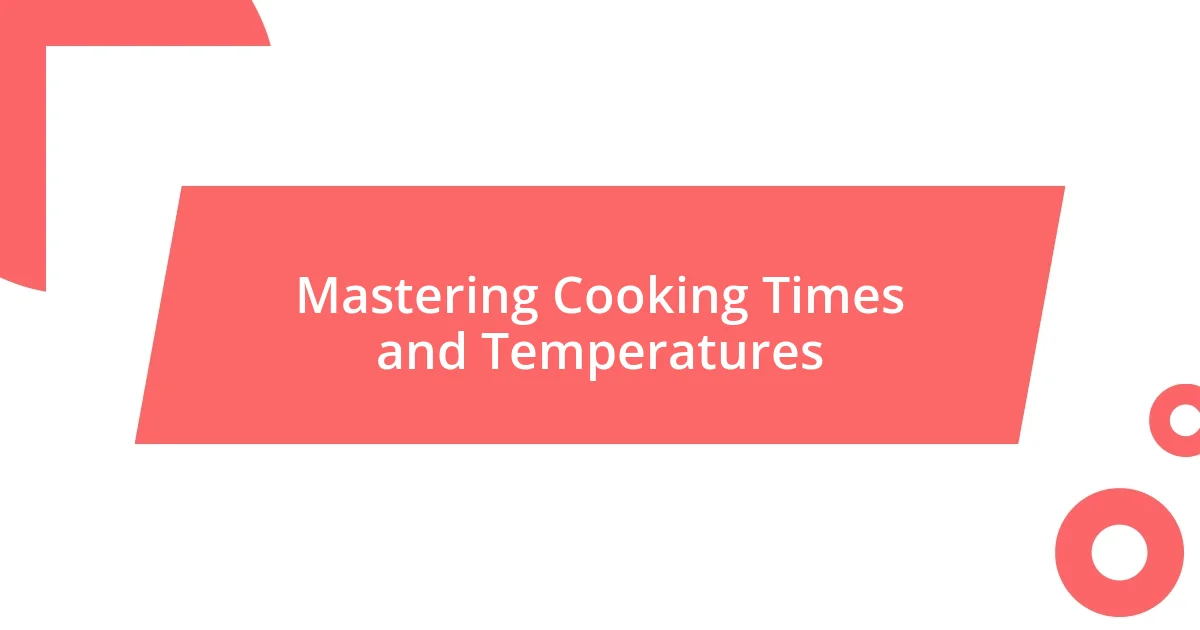Key takeaways:
- Sous vide cooking offers precise temperature control, leading to evenly cooked meals with enhanced flavors and tender textures.
- Essential equipment includes an immersion circulator, vacuum sealer, and a dedicated container to ensure efficient cooking and quality results.
- Choosing high-quality ingredients and understanding timing with herbs and spices can significantly elevate the flavor of sous vide dishes.

My Sous Vide Journey
When I first stumbled upon sous vide cooking, I was captivated by the idea of precision and control. I remember my first attempt: vacuum-sealing a steak and setting the immersion circulator on high. It was a mix of excitement and anxiety — would it truly be as tender and juicy as everyone claimed? Spoiler alert: it exceeded every expectation.
As I experimented more, I found sous vide to be a fantastic way to reclaim my evenings. After a long day, the thought of coming home to perfectly cooked meals waiting for me was like a cozy hug. There was something magical about knowing that while I was busy with life, dinner was effortlessly preparing itself.
Then came the moment of culinary revelation: the day I sous vide a whole chicken. I sliced into it, and the juices flowed like a waterfall. I couldn’t help but think, “How did I ever roast a chicken the traditional way?” Each bite was a reminder of why I fell in love with cooking in the first place, and it drove me to dive even deeper into this remarkable technique.

Understanding Sous Vide Cooking
Sous vide cooking is all about precision. At its core, it involves sealing food in a vacuum bag and immersing it in a water bath at a carefully controlled temperature. This method ensures that every bite of your meal is cooked evenly, leading to a tender texture and rich flavors.
- Temperature Control: The magic lies in the ability to set your desired temperature, eliminating the guesswork.
- Uniform Cooking: Food cooks uniformly, preventing overcooking or dryness, resulting in succulent outcomes.
- Versatile Techniques: You can sous vide meats, vegetables, and even desserts, making it a versatile addition to your culinary repertoire.
- Time-Saving: Once the food is in the water bath, you can walk away, freeing you up to focus on other tasks.
I recall the first time I pulled a perfectly cooked filet mignon from the water bath. It was such an exhilarating experience — the vibrant pink inside, a perfect crust formed on the outside after a quick sear. That moment struck me: sous vide isn’t just cooking; it’s a transformative process that allows for creativity and exploration in the kitchen. It’s almost like science meets art, and every meal becomes an opportunity to express my passion for food.

Essential Equipment for Sous Vide
When mastering sous vide, having the right equipment is crucial for success. At a minimum, you’ll need an immersion circulator, which is the heart of this cooking method. I vividly remember the day I unboxed mine; it felt like I was peeling back the layers of a culinary adventure waiting to happen. Selecting the right one was a game-changer. I wanted something reliable and capable of maintaining precise temperatures, which is essential for achieving that perfect cook.
Beyond the immersion circulator, vacuum sealers are come in handy. They ensure that your food is tightly sealed, preventing water from seeping in. I opted for a handheld vacuum sealer for its convenience, and let me tell you, it made meal prep feel less like a chore and more like an exciting science project. Plus, vacuum-sealed bags are not just practical; they’re also a space-saver in the freezer.
Lastly, consider a container for your water bath. While any pot will work, a dedicated sous vide container helps maintain water temperature efficiently. After a few tries, I found that using a tall, narrow container minimized evaporation, keeping my setup tidy. It’s these thoughtful choices that turn the sous vide experience from ordinary to extraordinary.
| Equipment | Purpose |
|---|---|
| Immersion Circulator | Maintains precise temperatures for even cooking |
| Vacuum Sealer | Seals food to prevent water infiltration |
| Sous Vide Container | Holds water for the cooking process |

Choosing the Right Ingredients
When choosing the right ingredients for sous vide cooking, I like to focus on freshness and quality. I often think back to the first time I used farm-fresh vegetables. Their vibrant colors and crisp textures were a game-changer! It’s amazing how ingredients that are just days old can elevate a meal’s flavor and texture. Have you ever noticed how the simplest ingredient can shine when treated with care?
Proteins are another key player in the sous vide game. I can’t stress enough how crucial it is to select the right cut of meat. When I experimented with a chuck roast, I was hesitant, thinking it might turn out tough. But, after a 48-hour sous vide bath, I was astounded by the tenderness. The low-and-slow cooking made all the difference! It leads me to ask, what potential is hidden in the cuts we often overlook?
Lastly, don’t underestimate the power of herbs and spices. They transform a dish from mundane to extraordinary. I remember a time when I tossed in a handful of fresh thyme with chicken breasts. The aroma that filled my kitchen was nothing short of intoxicating. It taught me that using fresh herbs not only adds layers of flavor but also enhances the overall cooking experience. Have you explored the impact of a single herb in your dishes? You might be surprised at what a little fresh basil can do!

Mastering Cooking Times and Temperatures
When it comes to cooking times and temperatures in sous vide, precision is everything. I remember meticulously planning a dinner for friends and choosing to cook steaks. After researching, I settled on a temperature of 129°F for medium-rare. The anticipation was palpable as I waited for those steaks to finish cooking. Trust me, the one-hour wait felt like an eternity, but the moment we cut into those perfectly tender slices made it all worthwhile.
The beauty of sous vide lies in its forgiving nature. If you’re unsure about cooking time, you can always extend it without fear of overcooking, something I’ve found liberating. I once left a pork tenderloin in the water bath at 140°F for four hours instead of the usual two. The result was mouthwatering—a texture that was both juicy and flavorful, showing me that a little patience can yield delicious rewards. Have you ever tried pushing the limits? It opens up a world of culinary experimentation.
I often refer to sous vide cooking times as a guide rather than a strict rule. For example, I frequently cook vegetables at 183°F for around 45 minutes. The results rarely disappoint, transforming even the simplest carrots into sweet, flavorful bites. Wouldn’t it be delightful to know that a little adjustment in temperature and timing can completely change your dish? Embracing this flexibility has truly helped me master sous vide cooking, unlocking a new realm of possibilities in my kitchen.

Flavor Enhancements for Sous Vide
When it comes to enhancing flavors in sous vide cooking, infusing my proteins with bold marinades has always intrigued me. A memorable dish I prepared was salmon, which I marinated overnight in a mix of soy sauce, ginger, and garlic. The next day, as the fish cooked in the water bath, the aromatic flavors seeped into every inch of the fillet. Have you ever experienced that burst of flavor when you bite into a perfectly marinated dish? It’s an unforgettable sensation that simply elevates your meal.
I’ve also discovered that the timing of adding herbs can dramatically influence flavor. During one of my culinary experiments, I learned that adding fresh herbs too early can sometimes lead to a muted taste. Instead, I’ve started adding delicate herbs like dill and parsley in the last few minutes of cooking. The freshness they impart when added just before serving can be nothing short of extraordinary! Have you ever adjusted your herb timing? It’s a small change that brings a whole new dimension to your cooking.
The beauty of sous vide is that you can also play with smoke and fat to amplify flavors. I recall a particularly exciting venture where I smoked chicken thighs for a few hours before sealing them in the bag. The result was exceptionally rich and smoky, creating an unparalleled depth of flavor. Have you tried infusing your dishes with smoke? It’s a game-changer that opens up a world of delicious possibilities for your sous vide creations.

Troubleshooting Common Sous Vide Issues
Sometimes, issues arise in sous vide cooking that can leave you scratching your head. I once encountered a situation where my water bath wasn’t reaching the desired temperature, which turned dinner into a late-night endeavor. It felt frustrating at first, but I learned to keep a close eye on the immersion circulator’s calibration. The lesson I took away? Regularly check the temperature settings, as even a minor oversight can lead to significantly undercooked or overcooked food. What would you do if your sous vide machine let you down mid-cook?
Another common hiccup is when food gets stuck together in the bag, resulting in uneven cooking. I vividly remember the time I sealed up shrimp with too many of their friends in one pouch. The shrimp on the edges cooked perfectly, while the ones in the center ended up overcooked and rubbery. Now, I always make sure to arrange ingredients with space in between or use separate bags for larger quantities. Have you considered how the arrangement of your food could impact your cooking results?
Vacuum sealing failure can also throw a wrench in your sous vide plans. I had a particularly thrilling dinner planned with a whole chicken, only to discover that the seal had broken while cooking. Coming back to check on my creation to find a bag that had filled with water made my heart sink. Since then, I always double-check the sealing process and consider the use of high-quality bags designed specifically for sous vide. A little extra care here can save you from a culinary catastrophe. How does prevention play a role in your cooking adventures?















